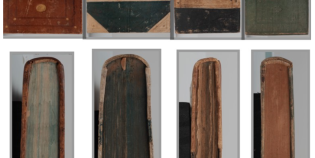In order to make beautiful paint colours, in the past, toxic materials were sometimes used. For example, arsenic was used to make the colour green. This paint was also used in some of the books in the KB’s collection. In recent years, it has become increasingly clear that we need to be more conscious of how we handle substances like arsenic. At the KB, we are therefore researching arsenic in our collection so that our staff and customers can handle the affected items safely. Read more about this KB expertise here.
Books with arsenic
In the past, arsenic was used to make the colour green. For a long time, green was a popular colour for embellishing book bindings and edges, for example. Its use peaked in the mid-nineteenth century. Schweinfurt green (also called Paris green or emerald green) was frequently used at that time. The KB also has pieces containing arsenic in its collection. It is difficult to determine exactly how many books in the KB collection are involved. We know that we have at least half a million signatures made during the period when arsenic-based paint was used most.
Not all books with green paint contain arsenic, and arsenic-containing paint is not always green either. Arsenic can become discoloured when it comes into contact with oxygen, turning yellow or brown, for example. And arsenic has also been found in some blue-coloured books. To know for sure whether arsenic is contained in a book, a detection test is needed.
Research
How can we best detect arsenic-containing books in our collection? Does arsenic spread? And how do we determine whether employees absorb or ingest arsenic during their work? When the KB established the arsenic project team in 2020, these questions formed the starting point.
We use a special test to show whether the paint used in books contains arsenic. We conduct these tests in our restoration studio. We then take a wipe sample of a book and determine whether it contains arsenic, or not. These tests are very time-consuming. Therefore, they are not suitable for detection on a larger scale. We are currently investigating suitable methods for this.
Besides testing collection items (for the presence of arsenic), the KB has also had other research conducted. Among other things, we took air samples in places where arsenic-containing items from the collection are commonly used. From this research, we know that the arsenic from our books does not spread through the air in the KB.
From taking wipe samples, we also know that the paint isn’t always colourfast. The KB has therefore established a safety protocol for staff handling these books. This protocol has three parts: wearing personal protective equipment, cleaning the surfaces used and washing hands before and after working with the collection.
It is important to the KB that all of its staff can do their jobs in a safe and healthy manner. To investigate whether there is a risk of staff ingesting or absorbing arsenic when working with these books, the KB commissioned an exposure study. Staff members who work with this collection frequently or for long periods of time were able to take part in this study on a voluntary basis. The exposure study showed that no relationship could be established between handling these books and the presence of arsenic in the body. We will continue to repeat these studies to check whether the results remain the same.
Safety
To ensure that employees and customers are not exposed to arsenic, the KB has established the above-mentioned safety protocol. Staff members must wear nitrile gloves and an FFP3 mask while working with this collection. In addition, the books are placed on a paper liner. Surfaces that come into contact with these books are also cleaned more frequently.
This protocol also applies to customers requesting books containing arsenic. Books known to contain arsenic are packed in special boxes. The staff member at the Special Collections desk then explains that the collection piece may be viewed only when the accompanying protective equipment provided is used. Afterwards, the collection item is placed back in the box and returned at the desk and the used protective equipment is disposed of safely.
Knowledge sharing
Arsenic was also used for other things in the past, for example, in pesticides and in taxidermy. It was used on a large scale, not only in the Netherlands but also internationally. Consequently, many other libraries, heritage archives and natural history institutions have arsenic-containing materials in their collections. The KB is one of the first heritage institutions to research this on a large scale. We believe it is important to increase knowledge about arsenic in heritage collections.
The KB would like to conduct more extensive research on the use of arsenic and other potentially harmful substances that may have been used in the past. The KB is preparing to conduct such research together with its network partners. This will make it possible to broaden and share the necessary knowledge internationally.
De KB in het nieuws over arsenicumhoudende collectie
RTL4 EditieNL: KB verwijdert giftige boeken: hoe schadelijk zijn ze?
NOS radio 1 journaal: De uitdaging van arsenicumhoudende collectie (Terugluisteren vanaf 22 minuten)







